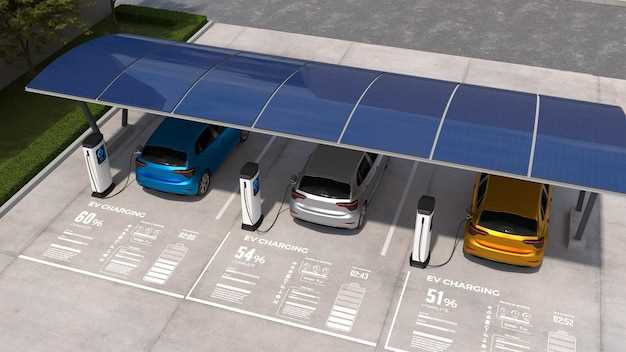
The rapid growth of the electric vehicle (EV) market has prompted a search for innovative charging solutions that enhance sustainability and efficiency. One of the most promising developments in this field is the integration of solar panels into EV designs. This synergy not only aims to reduce dependency on conventional electricity sources but also empowers users to harness renewable energy directly from the sun.
Solar charging technology allows electric vehicles to convert solar energy into electrical energy via solar panels installed on the vehicle’s exterior. This integration offers numerous benefits, including extended range and reduced charging time. As vehicle manufacturers explore various designs, the optimization of these solar panels plays a crucial role in maximizing energy efficiency and performance.
Moreover, the advent of solar technology in EV systems signifies a shift toward a more sustainable transportation model. By utilizing solar energy, drivers can significantly decrease their carbon footprint, contributing positively to the fight against climate change. As this technology advances, the future of electric mobility is poised to become not only more sustainable but also increasingly self-sufficient.
Assessing the Feasibility of Solar Panel Installation on EVs

The integration of solar panels into electric vehicles (EVs) presents a promising opportunity to enhance the sustainability and energy efficiency of transportation. However, assessing the feasibility of such installations involves multiple factors, including efficiency, weight, cost, and vehicle design.
Solar panels convert sunlight into electricity, potentially allowing EVs to harness renewable energy during daytime travel. The energy produced can be used to power the vehicle’s electric systems or charge the battery, thereby extending the driving range. However, the efficiency of solar panels is a crucial consideration, as typical solar technology yields only a fraction of the energy needed for full vehicle operation.
Weight is another significant concern. Installing solar panels adds to the overall mass of the EV, which can affect its performance and energy efficiency. Automotive engineers must design vehicles that can support solar panels without compromising their aerodynamic properties or increasing energy consumption significantly.
Cost implications also play a vital role in the feasibility of solar installations. The initial investment for high-efficiency solar panels and their integration into the vehicle’s structure must be weighed against long-term fuel savings and potential government incentives for green technology. The return on investment (ROI) can vary based on geographic location, as solar energy production is contingent on local weather conditions.
Further, regulatory and safety standards must be addressed when incorporating solar panels into EV designs. These include ensuring that the panels do not interfere with vehicle functionality or safety systems. Collaboration between automakers, solar technology providers, and regulatory bodies is essential for successful implementation.
In conclusion, while the potential benefits of solar panel installation on electric vehicles are significant, thorough feasibility assessments are necessary. Considerations around efficiency, weight, cost, and compliance with safety standards will ultimately determine the practicality of this innovative approach in the automotive industry.
Evaluating Energy Output from Solar Panels for EV Efficiency
Integrating solar panels into electric vehicles (EVs) presents a promising avenue to enhance energy efficiency. The primary consideration in this integration is the quantification of the energy output that these solar panels can consistently provide, especially during varying environmental conditions.
To evaluate the energy output, it is essential to consider factors such as the efficiency of the solar cells, the surface area available for panels, and the geographical location of the vehicle. Most solar panels in use today have efficiencies ranging from 15% to 20%, meaning they convert that percentage of sunlight into usable electrical energy. With average sunlight exposure varying significantly across different regions, conducting a thorough assessment based on local weather patterns and average sunlight hours is crucial for accurately estimating potential energy yields.
The energy output can be calculated using the formula:
Energy Output (kWh) = Area of Solar Panels (m²) × Efficiency (%) × Average Solar Irradiance (kW/m²) × Sunlight Hours (h)
This equation allows stakeholders to forecast the amount of energy generated by the solar panels monthly or annually, enabling a clearer understanding of how much solar energy can contribute to the EV’s total energy needs. For example, if an EV is equipped with 2 m² of solar panels with an efficiency of 18% in an area that receives about 5 kWh/m² of solar irradiance daily, the energy output will be substantial over time.
Furthermore, the integration of solar panels does not merely add to the vehicle’s energy supply; it also enhances the efficiency of existing battery systems. By reducing reliance on grid power or charging stations, solar panels can lower the overall carbon footprint of electric mobility. Additionally, it provides the potential for extended range when traveling in sunny environments.
In conclusion, evaluating the energy output from solar panels is fundamental in determining their viability for improving EV efficiency. Through careful analysis and real-world testing, the application of solar energy in electric vehicles can redefine sustainable transportation.
Exploring Cost-Benefit Analysis of Solar Charging Systems for Electric Vehicles

The integration of solar charging systems into electric vehicles (EVs) presents a promising avenue for enhancing energy efficiency and reducing operational costs. A detailed cost-benefit analysis is essential to evaluate the feasibility and long-term advantages of deploying solar panels on EVs. This analysis considers both initial investment and ongoing benefits associated with solar energy utilization.
Initial costs primarily involve the purchase and installation of solar panels on the vehicle’s surface. While the upfront investment can be significant, advancements in solar technology are progressively lowering these expenses. Additionally, the compact and lightweight solar panels designed specifically for vehicles can maximize space while optimizing energy absorption.
On the benefit side, solar panels provide a sustainable energy source that can reduce the reliance on conventional grid electricity. This energy generation capability allows EV owners to harness renewable energy during driving or parked periods, potentially leading to substantial savings on electricity bills and charging costs. Furthermore, the use of solar energy can result in decreased emissions, contributing to a greener environment–a value that is increasingly recognized in today’s market.
The economic viability of solar charging systems also hinges on the geographic location and climate conditions. Regions with abundant sunlight can significantly enhance the energy output from solar panels, leading to faster return on investment. In areas with less sunlight, the effectiveness of solar panels may diminish, requiring careful evaluation of energy needs against harnessing potential.
Moreover, maintenance costs for solar charging systems are generally low. The durability of solar panels combined with minimal maintenance requirements means that once installed, they can provide long-term benefits without incurring substantial additional costs.
Ultimately, the cost-benefit analysis of integrating solar charging systems in electric vehicles illustrates that while the initial investment may be considerable, the long-term savings, reduced environmental impact, and energy independence create a compelling case for their adoption. As technology progresses and prices continue to decline, the proposition for solar-powered EVs will become increasingly attractive to consumers, manufacturers, and policymakers alike.


